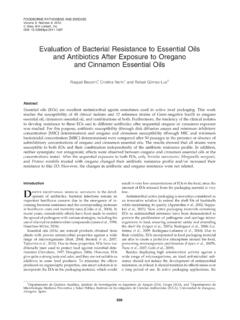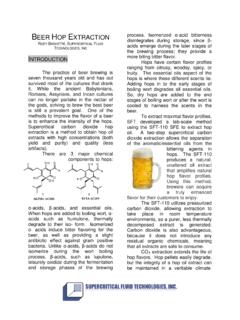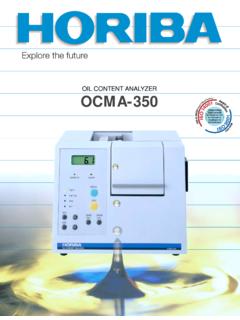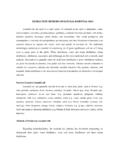Transcription of Extraction of rosemary essential oil by steam …
1 FLAVOUR AND FRAGRANCE JOURNAL essential OIL OF ROSMARINUS OFFICINALIS 481. Flavour Fragr. J. 2003; 18: 481 484. Published online 1 October 2003 in Wiley InterScience ( ). DOI: Extraction of rosemary essential oil by steam distillation and hydrodistillation C. Boutekedjiret,1 F. Bentahar,2 R. Belabbes1 and J. M. Bessiere3. 1. Ecole Nationale Polytechnique, D partement de G nie Chimique, 10 Avenue Hacene Badi, BP 182, El-Harrach, Alger, Alg rie 2. Laboratoire des Ph nom nes de Transfert, D partement de G nie des Proc d s, Facult de G nie M canique et G nie des Proc d s, USTHB, BP 32 El Alia, 16111 Bab-Ezzouar, Alger, Alg rie 3. Ecole Nationale Sup rieure de Chimie de Montpellier, 34000 Montpellier, France Received 5 June 2002. Revised 20 January 2003. Accepted 21 January 2003. ABSTRACT: rosemary oil was extracted by both steam and hydrodistillations then analysed by gas chromato- graphy and gas chromatography mass spectrometry.
2 The effect of time of Extraction enabled us to follow the evolu- tion of the yield and oil composition obtained by both processes. Copyright 2003 John Wiley & Sons, Ltd. KEY WORDS: Rosmarinus of cinalis L; rosemary ; Labiatae; essential oil composition; Extraction ; steam distilla- tion; hydrodistillation Introduction To extract the essential oil by steam distillation, the vegetable matter was placed in a glass column, of which rosemary (Rosmarinus of cinalis. L) is an aromatic, the lower and higher parts were connected to a water medicinal and condiment plant that belongs to the Family ask and a condenser, respectively. The water vapour Labiatae. It is widely spread in Algeria and broadly used produced in the ask crosses the plant, charged with in traditional medicine. rosemary is selected because it essential oil then to the condenser, where it is condensed.
3 Is of interest as a preservative due to its antioxidative After condensation, the oil is separated from water by characteristics and it is used in the pharmaceutical, food decantation. The Extraction of essential oil by hydro- and cosmetic industries. Therefore this work was under- distillation was carried out under the same conditions as taken in order to contribute to a better knowledge of the the steam distillation. The only difference is that in this essences of rosemary coming from the area of Bibans, case the vegetable matter is laid out in the ask contain- located approximately 200 km east of Algiers, and, more ing water and the unit is carried to boiling. The vapour speci cally, to compare rosemary essential oils obtained mixture of water oil produced in the ask then passes to by steam and hydrodistillations from a qualitative and the condenser, where it is condensed.
4 The oil is recovered quantitative point of view. after decantation. The essential oils obtained by both extractions were analysed by gas chromatography (GC) and gas Experimental chromatography mass spectrometry (GC MS) under previously established operating ,3 A 25 m . The vegetal matter used comes from the Portes de Fer' mm fused silica capillary column coated with in the Bibans area, located 200 km east of Algiers and polydimethylsiloxane (DBP-1) of m lm thickness identi ed according to the Flora of A sample was the column tted in the GC an GC MS systems. specimen was deposited in the Herbarium of the Botany The column temperature was computed to start at 60 C, Department at the Algeria National Institute of Agronomy. increasing to 200 C at 3 C/min. The carrier gas at Identi cation of the plant was con rmed by Montpellier 1 ml/min was nitrogen for GC and helium for GC MS.
5 University botanists and the Biology Institute of Algiers In addition, the oil was recovered at regular time intervals University of Sciences and Technology. Extractions were and analysed by GC in order to follow yield and oil realized on a laboratory scale. composition. The essential oil yield was estimated according to the dry vegetal matter by using the follow- ing equation: * Correspondence to: C. Boutekedjiret, Ecole Nationale Polytechnique, D partement de G nie Chimique, 10 Avenue Hacene Badi, BP 182, El- mHE. Harrach, Alger, Alg rie. RHE (%) = 100 (1). E-mail: mS. Copyright 2003 John Wiley & Sons, Ltd. Flavour Fragr. J. 2003; 18: 481 484. 482 C. BOUTEKEDJIRET ET AL. where mHE = essential oil mass (g), mS = dry vegetal literature,6 13 more speci cally to those of the Tunisian matter mass (g) and RHE = essential oil yield (%).
6 And Greek oils14 15 and to commercial This oil has high monoterpene hydrocarbons and ether con- tents, even though the water-distilled oil is characterized Results and Discussion by high ketone, alcohol and ester contents. The contents of the sesquiterpenes were practically the same. Identification of the Components of the The monoterpene hydrocarbons compounds are in essential Oil small proportions in the hydrodistilled oil, due to chem- ical conversions in the presence of water, resulting from The identi cation of the components of the essential oil hydrolysis reactions of these components in monoterpene extracted by both steam and hydrodistillations was carried alcohol's components. The quantitative differences in the out by comparison of their mass spectra and retention rosemary oils composition may be due to Extraction pro- times to those of reference ,5 The results are cesses, as previously reported by presented in Table 1.
7 From this table, it can be seen that these oils were characterized by the presence of monoterpene hydro- Yield and essential Oil Composition as Function carbons, oxygenated monoterpenes and sesquiterpenes, of Time but the quantitative differences were observed in the contents of these components. The steam distillation The yield of essential oil obtained by the steam distilla- oil composition is comparable to that reported in the tion is This value is comparable to that given by Fournier et for Tunisian rosemary . The yield of the hydrodistillation is much lower at only The essen- Table 1. Chemical composition of rosemary essential tial oil yield as a function of time is shown in Figure 1, oil extracted by steam distillation and hydrodistillation and all oils are recovered after 30 min. In addition, the Components Relative content (%) yield increases quickly at the beginning of the Extraction , its evolution becoming slower thereafter.
8 Moreover, after steam distillation Hydrodistillation 10 min steam distillation more than 80% of essential oil -Pinene are recovered; whereas for the hydrodistillation it takes at Camphene least 30 min to extract 88% of the oil. -Pinene Analysis by gas chromatography of the oil recovered Myrcene tr -Phellandrene tr tr with regular time intervals enabled us to follow the p-Cymene tr evolution by time of the relative content of some major 1,8-Cineol components of oil belonging to various known chem- -Terpinene tr Sabinene hydrate ical families: 1,8-cineol, camphor, borneol, -terpineol, Terpinolene tr bornyl acetate, -caryophyllene and -cadinene, as Linalol shown in Figures 2 and 3. Figure 2 shows a rapid evolu- Camphor Borneol tion of the content of the considered components, and Terpinene-4-ol those recovered in the ascending order of their boiling -Terpineol points.
9 Indeed, in the steam distillation, the 1,8-cineol Bornyl acetate Thymol tr is mostly recovered in the rst 5 min of the process, Carvacrol tr followed by camphor, borneol and -terpineol, which Eugenol tr reach their maximum contents after 10 min Extraction ;. -Copaene -Caryophyllene -Humulene tr Germacrene D tr -Muurolene tr -Farnesene tr -Cadinene tr Calamenene tr tr -Cadinene tr Calacorene tr -Cadinene tr tr Caryophyllene oxide I tr Caryophyllene oxide II tr Humuladienol tr . Humulene oxide tr . Palmitic acid tr Miristic acid tr tr tr, trace < Figure 1. Evolution of the essential oil yield by time Copyright 2003 John Wiley & Sons, Ltd. Flavour Fragr. J. 2003; 18: 481 484. essential OIL OF ROSMARINUS OFFICINALIS 483. Figure 2. Evolution of the content of some components of rosemary essential oil during steam distillation Figure 3.
10 Evolution of the content of some components of rosemary essential oil during hydrodistillation then the -caryophyllene follows them with a maximum The 1,8-cineol and camphor are recovered in greater content after 15 min and nally the -cadinene with an proportion after 10 min hydrodistillation, as shown in optimal content after 20 min of steam distillation. The Figure 3. We observe thereafter the simultaneous extrac- fact that the components considered are recovered in tion of borneol, -terpineol, bornyl acetate and - the ascending order of their boiling points allows us to caryophyllene, which reach their optimal contents after suppose that the steam distillation depends on phenomena 20 min of the process. After 30 min, only traces of these of transfer of the oil located at the surface of the plant components are recovered.













